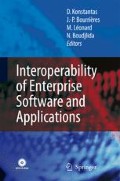Summary
The Business Process Execution Language (BPEL) is an XML based language; the BPEL standard defines the structure, tags and attributes of an XML document that corresponds to a valid BPEL specification. In addition, the standard defines a number of natural language constraints of which some can be ambiguous and are complex. This paper uses the Unified Modelling Language (UML) and Object Constraint Language to provide a model of the XML based BPEL language. Based on this model the paper shows how OCL can be used to give a precise version of the natural language constraints defined in the BPEL standard. We then use this precise specification to generate a Validation tool automatically that can check that a BPEL document is well-formed.
Access this chapter
Tax calculation will be finalised at checkout
Purchases are for personal use only
Preview
Unable to display preview. Download preview PDF.
References
Akehurst D. H., “Validating BPEL Specifications Using OCL,” University of Kent at Canterbury, technical report: 15-04, August 2004.
Akehurst D. H. and Patrascoiu O., “OCL 2.0 — Implementing the Standard for Multiple Metamodels,” in proceedings UML 2003 Workshop, OCL 2.0-Industry standard or scientific playground?, San Francisco, USA, October 2003.
Buneman P., Fan W., Simeon J., and Weinstein S., “Constraints for Semi-structured Data and XML,” SIGMOD Record (ACM Special Interest Group on Mangement of Data), vol. 30, pp. 47–54, 2001.
Eclipse.org, “Eclipse Modelling Framework (EMF),” www.eclipse.org/emf
Fan W. and Simeon J., “Integrity Constraints for XML,” Journal of Computer and System Sciences (JCSS), vol. 66, pp. 254–291, February 2003.
Hu J., “Visual Modeling of XML Constraints Based on A New Extensible Constraint Markup Language,” thesis, Department of School of Computer Science and Information Systems, Pace University, 2003
IBM, “Business Process Execution Language for Web Services,” 2003, www.ibm.com/developerworks/library/ws-bpel/
Kleppe A. and Warmer J., “The Object Constraint Language and its application in the UML metamodel,” in proceedings «UML»’98 Beyond the Notation, Mullhouse, France, June 1998.
Meißner E., “XML-Constraints with Scheme,” in proceedings XML Europe 99, Granada, May 1999.
Nentwich C., Capra L., Emmerich W., and Finkelstein A., “xlinkit: A Consistency Checking and Smart Link Generation Service,” ACM Transactions on Internet Technology, vol. 2, pp. 151–185, May 2002.
OMG, “Model Driven Architecture (MDA),” Object Management Group, ormsc/2001-07-01, July 2001.
OMG, “Request for Proposal: MOF 2.0 Query / Views / Transformations RFP,” Object Management Group, ad/2002-04-10, April 2002.
OMG, “The Unified Modeling Language Version 1.5,” Object Management Group, formal/03-03-01, March 2003.
W3C, “XSL Transformations (XSLT) Version 1.0,” J. Clark (eds), W3C Remomendation, REC-xslt-19991116, November 1999.
W3C, “Web Services Definition Language (WSDL) 1.1,” 2001, http://www.w3.org/TR/wsdl
Author information
Authors and Affiliations
Editor information
Editors and Affiliations
Rights and permissions
Copyright information
© 2006 Springer-Verlag London Limited
About this paper
Cite this paper
Akehurst, D.H. (2006). Experiment in Model Driven Validation of BPEL Specifications. In: Konstantas, D., Bourrières, JP., Léonard, M., Boudjlida, N. (eds) Interoperability of Enterprise Software and Applications. Springer, London. https://doi.org/10.1007/1-84628-152-0_24
Download citation
DOI: https://doi.org/10.1007/1-84628-152-0_24
Publisher Name: Springer, London
Print ISBN: 978-1-84628-151-8
Online ISBN: 978-1-84628-152-5
eBook Packages: Computer ScienceComputer Science (R0)

